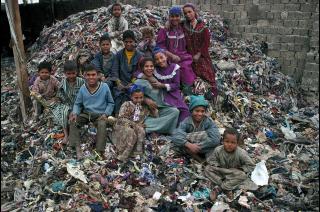What is the environment?
The environment is made up of ecosystems. Ecosystems are life support systems on which we rely to survive. Ecosystems work on the basis of continuous cycles whereby elements are recycled in nature and re-used by living organisms. But these cycles in the environment are extremely sensitive to change; what you put in is what you get out. Below are examples of the importance of biomes – a collection of similar ecosystems – in our everyday life.
- Rainforests are a significant source of the world’s medicinal plants. Up to 80% of all people living in developing countries rely on traditional medicines derived from natural extracts compared to 25% in the West. But less than 1% of tropical plant species have been tested by scientists to date.
- Oceans contain 80% of the earth’s resources and remove about 25% of carbon dioxide emitted by human activities. But less than 1% of them are protected.
- Drylands cover more than 40% of the planet’s surface and are home to one-third of the world’s population.
Where do we stand?
Our relationship with our environment can be a little one-sided; while humans like to consume we do not always feed back into ecosystem cycles. As a result we leave our resources significantly depleted.
- Half of the forests that originally covered 48% of the Earth's land surface are gone. Deforestation continues at an alarming rate of about 13 million hectares per year (roughly equivalent to the land area of Bangladesh).
At the same time human beings are also notorious polluters and creators of waste, neglecting to recycle much of what they use, and collectively producing mountains of rubbish.
- On average every person in the UK throws away their own body weight in rubbish every seven weeks, and collectively the UK produces enough waste in two hours to fill the Royal Albert Hall.
- Oceans are covered by 46,000 pieces of plastic litter per square mile. In the Pacific a vortex drawing waste in from the US and Japan has resulted in the formation of a floating garbage patch, spanning an area twice the size of Texas.
What are the consequences?
The consequences that our actions have for the environment in turn affect us. They multiply, have knock on effects and multiply again. Natural and manmade disasters like the Chernobyl disaster, the flooding caused by the Three Gorges dam in China and the spread of the Sahel drylands have forced thousands, sometimes millions of people, to be displaced, leaving their land or country of origin.
- Natural and manmade disasters or the impact of climate change caused an estimated 25 million people to become ‘eco-refugees’ in 1998.
An example of these knock-on effects in action:
- It is estimated that in Central Asia alone, 8,000 to 10,000 square kilometres of desert are created every year where cattle once grazed or lakes once existed.
- By the year 2020, experts estimate that 60 million people will be forced to move from newly desertified areas of sub-Saharan Africa if present trends continue.
- Desertification of land has driven more people from the land towards urban centres. The share of urban-to-total world population increased from 29% in 1950 to 50% in 2008.
- This dry land is harder to cultivate and with fewer people living in rural areas to tend the land, there is as a result increased levels of child labour and poverty.
- Those arriving in the city are vulnerable to poor living conditions, exploitation and even slavery. Children are especially exposed.
Biodiversity of species in the environment also suffers because of human activity.
- Scientists indicate that between 150 and 200 species become extinct every 24 hours.
Human activity is in danger of exhausting the environment.
- Over 75%of the world's fish stocks are fully exploited, overexploited or depleted. Unless the current situation improves, stocks of all species currently fished for food are predicted to collapse by 2048 – your children’s lifetime.
What is the UN doing?
The United Nations Environment Programme (UNEP) established 1972 is the voice for the environment in the UN system. UNEP advocates a sustainable approach to the environment which means adopting a long-term view of how our actions affect future generations.
- UNEP provides support to national governments, especially in the developing world to participate in international negotiations and enact legislation to protect the environment.
The environment is a key focus of the UN’s main development initiative – the Millennium Development Goals – eight time-bound goals signed by world leaders in 2000. Goal 7 aims to ensure environmental sustainability and to encourage country policies to reverse the loss of environmental resources.
- One success of the MDG effort is that the use of ozone depleting gases has been completely eliminated worldwide. But many more challenges still lie ahead.

